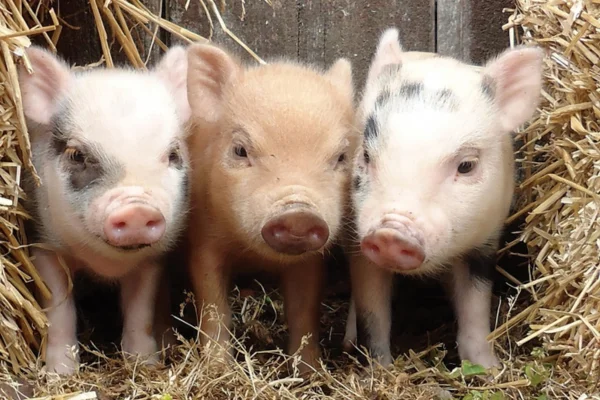Ascariasis in Pigs: Prevention, Symptoms and Treatment
Ascaridosis in pigs:
Pig farming plays a vital role in the agricultural economy and is one of the most traditional and profitable activities in Brazil. However, the success of this practice can be seriously compromised by the occurrence of parasitic diseases, such as ascariasis. This infection, caused by the worm Ascaris suum, is one of the most common endoparasitoses in pigs and is responsible for significant losses in terms of both animal health and productivity. In this article, we will explore in detail what ascariasis is, its symptoms, forms of prevention and treatment, as well as discussing the importance of effective control measures to guarantee the health of pigs and the quality of production.
What is Ascariasis?
Ascariasis is a parasitic disease caused by the nematode Ascaris suum, a worm that can reach up to 40 cm in length in its adult stage. This parasite is extremely common in pig farms, especially in extensive production systems or under inadequate hygiene conditions. Ascaris suum eggs are very resistant and can survive for long periods in the environment, being spread mainly through the feces of infected animals.
Parasite Life Cycle
To understand the seriousness of ascariasis, it is essential to know the life cycle of Ascaris suum. The cycle begins when pigs ingest food or water contaminated with the parasite's eggs. These eggs hatch in the small intestine, releasing larvae that penetrate the intestinal wall and enter the bloodstream. From there, the larvae migrate to the liver and then to the lungs, where they cause lesions before being coughed up and re-ingested. On returning to the small intestine, the larvae mature into adult worms, completing the cycle.
Contents
This migratory cycle not only causes direct damage to the pigs' internal organs, but also impairs the animals' growth and feed efficiency, resulting in significant economic losses.

Symptoms and Impacts on Pig Health
The clinical signs of ascariasis can vary depending on the severity of the infestation. In mild infections, pigs may show no visible symptoms, but in more severe cases, signs may include:
- Loss of appetiteInfected pigs often show a reduced appetite, which leads to weight loss and slow growth.
- Coughing and difficulty breathingDue to the migration of the larvae through the lungs, animals can develop respiratory symptoms such as coughing and difficulty breathing.
- Diarrhea: The presence of worms in the intestine can cause irritation and inflammation, resulting in diarrhea.
- Dull coat and lack of vitalityAffected animals may appear weak, with dull coats and a lack of energy.
- Intestinal obstructionIn extreme cases, massive worm infestation can lead to intestinal obstruction, which can be fatal if left untreated.
In addition to the clinical signs, ascaridosis can have a serious impact on the productivity of the farm. Reduced weight gain, increased time to slaughter and inefficient feed consumption are direct consequences of the infection, which poses a significant threat to the profitability of pig production.
Diagnosis of Ascariasis
Ascariasis is usually diagnosed by analyzing the feces of pigs, where the parasite's eggs can be identified. However, as the clinical symptoms can be non-specific and similar to other diseases, it is important to carry out complementary laboratory tests to confirm the presence of Ascaris suum. In addition, during slaughter, inspection of the internal organs, especially the liver and lungs, can reveal lesions characteristic of larval migration, helping to confirm the diagnosis.
Prevention and Control of Ascariasis
Preventing ascariasis in pigs is essential to avoid economic losses and deterioration in the animals' health. The main prevention measures include:
- Strict hygieneKeeping facilities clean and dry is crucial to reducing the spread of parasite eggs. Regular cleaning of feeders and drinkers, as well as frequent removal of faeces, can help minimize the risk of infection.
- Proper handlingThe implementation of proper pig management, including stocking density control and separation of animals by age, can reduce exposure to the parasite.
- Pasture rotationIn outdoor production systems, rotational grazing can be an effective strategy for interrupting the life cycle of Ascaris suum and avoiding re-contamination of the animals.
- Regular wormingPeriodic administration of dewormers is one of the main strategies for controlling ascariasis. It is important to follow an appropriate deworming protocol, taking into account veterinary recommendations and parasite resistance.
- Education and awarenessTraining farm workers to recognize the signs of infection and implement hygienic management practices is essential for effective disease control.
Treatment of Ascariasis
The treatment of ascariasis in pigs is mainly carried out through the use of anthelmintics, which are drugs capable of eliminating the worms from the animals' bodies. There are various types of anthelmintics available on the market, and the most suitable product should be chosen based on a veterinary assessment, taking into account the severity of the infestation and the parasite's resistance.
Some of the most common anthelmintics include:
- BenzimidazolesEffective against adult worms and larvae, they are widely used in parasite control programs.
- IvermectinWidely used due to its effectiveness against a wide range of internal and external parasites.
- Levamisole: A broad-spectrum anthelmintic that is also effective against other parasitic diseases.
It is important to follow the drug's dosage recommendations and grace period to ensure food safety and treatment efficacy.

Challenges and Final Thoughts
Despite the various control and treatment strategies available, ascariasis in pigs remains a significant challenge for the pig industry. Parasite resistance to anthelmintics is a growing concern, requiring an integrated approach that combines proper management, hygiene practices, pasture rotation and the judicious use of drugs.
In addition, the ongoing education of producers and farm workers is fundamental to ensuring the effective implementation of control measures and preventing the spread of the disease. Collaboration with veterinarians and parasitology experts also plays a crucial role in the management of ascariasis, ensuring that the practices adopted are based on scientific evidence and adapted to the specific needs of each farm.
In conclusion, ascariasis in pigs is a parasitic disease that can cause significant damage to both the health of the animals and the productivity of the farm. However, with the adoption of effective preventive measures and adequate treatment, it is possible to minimize the impacts of this parasitosis and guarantee the well-being of pigs and the sustainability of pig production.








